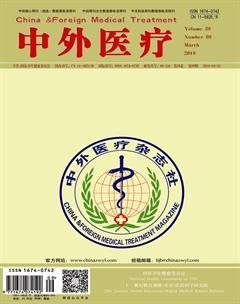莫西沙星可濃度依賴性增加人氣道平滑肌細胞Caveolin—1的表達
李慧婷 趙杰 李海泉 施萍 張衍民 杜永亮
[摘要] 目的 觀察在不同濃度的莫西沙星作用下,人氣道平滑肌細胞(HASMC)小凹蛋白-1(Caveolin-1,Cav-1)蛋白及mRNA表達的變化,探討莫西沙星對HASMC發揮抗炎調節的可能機制。 方法 購買HASMC,體外傳代培養,按隨機數字表法分為空白對照組(M0)、莫西沙星5 mg/L(M5組)、10 mg/L(M10組)、20 mg/L(M20組),均孵育48 h后,分別應用Western blot和qRT-PCR檢測Cav-1蛋白水平及mRNA表達。 結果Western blot檢測顯示,各莫西沙星濃度組(M5組、M10組、M20組)Cav-1蛋白表達分別為(3.02±0.43),(4.18±0.07),(4.44±0.14),均明顯高于空白對照組(M0組)(1.00±0.15)(P<0.05),同時也存在濃度依賴性(r=0.77)。qRT-PCR結果顯示各莫西沙星組(M5組、M10組、M20組)Cav-1 mRNA表達量(2.54±0.35),(3.26±0.22),(5.57±0.51)均較空白對照組(M0組)表達量(1.00±0.11)明顯增加(P<0.05),同時存在濃度依賴性(r=0.99)。 結論 莫西沙星可濃度依賴性增加HASMC Cav-1蛋白及mRNA表達,這可能與莫西沙星對ASMC發揮抗炎作用相關。
[關鍵詞] 莫西沙星;肌細胞,平滑肌;小凹蛋白-1
[中圖分類號] R562.2 [文獻標識碼] A [文章編號] 1674-0742(2019)03(c)-0011-04
[Abstract] Objective To culture human airway smooth muscle cells (HASMCs) with moxifloxacin at various concentrations, then to observe the effects of moxifloxacin on the expression of the protein and mRNA of Cav-1, and to explore the possible mechanisms of anti-inflammatory effects of moxifloxacin on HASMCs. Methods HASMCs were bought and cultured in vitro. The cells were randomly divided into 4 groups including a control group (M0) and 3 groups to which moxifloxacin was added at different concentrations (5,10,20)mg/L, groups M5, M10 and M20 respectively). Then the cells of different groups were incubated for 48 h. Finally the protein of Cav-1 was measured by Western blot and the mRNA of Cav-1 was measured by qRT-PCT respectively. Results The results of Western blot indicated that the expression of Cav-1 increased with the concentrations of moxifloxacin increasing (3.02±0.43), (4.18±0.07),(4.44±0.14) respectively, and the expression of Cav-1 of these groups were all higher than that of the control group (1.00±0.15)(P<0.05), The expression of Cav-1 showed a positive correlation with the concentration of moxifloxacin (r=0.77). The results of qRT-PCR showed that the expression of mRNA of Cav-1 of different moxifloxacin groups M5,M10 and M20 (2.54±0.35),(3.26±0.22),(5.57±0.51) respectively were all higher than that of the control group (1.00±0.11)(P<0.05). There was also a positive correlation between the mRNA of Cav-1 and the concentration of moxifloxacin (r=0.99). Conclusion Moxifloxacin could increase the expression of Caveolin-1 of HASMCs in concentration-dependent manner, which may be the possible mechanism concerning the anti-inflammatory effects of moxifloxacin.
[Key words] Moxifloxacin; Myocytes, Smooth muscle; Caveolin-1
哮喘患者ASMC呈現病理狀態,其可分泌大量炎癥因子(如IL-6、IL-8及Eotaxin)[1],這些炎癥介質可導致氣道炎癥持續級聯放大,反過來影響ASMC,致其增殖增加及收縮增強,參與哮喘發病。我們前期研究發現莫西沙星可抑制大鼠ASMCs炎癥因子IL-8及Eotaxin的分泌[2],但具體機制尚不清楚。近年來研究發現Cav-1在氣道炎癥中擔當著重要角色,且哮喘患者Cav-1水平明顯下調[3],提示Cav-1對哮喘性氣道炎癥具有保護作用,但其具體作用機制尚不完全清楚。該研究旨在探討莫西沙星對HASMC的Cav-1蛋白及mRNA表達的影響,探索莫西沙星對ASMC抗炎作用發揮的可能機制。報道如下。
1 資料與方法
1.1 一般資料
莫西沙星(德國拜耳醫藥保健股份公司),Cav-1人抗山羊單克隆抗體(16447-1-AP,proteintech公司),二抗山羊抗兔IgG H&L (HRP) (ab6721,abcam公司),HSMC(3410-c,sciencell,上海武光生物科技有限公司),平滑肌細胞培養液(1101,sciencell,上海武光生物科技有限公司),熒光定量檢測試劑盒(RR420A,上海馳勇生物科技有限公司)。
1.2 方法
①HASMC的培養及傳代:購買得到HASMC原代細胞,貼壁法進行細胞培養,以胰酶消化法進行HASMC傳代并自然純化細胞,實驗取5-6代細胞。
②Western blot檢測Cav-1蛋白表達:用不同濃度(5,10,20 mg/L)莫西沙星處理HASMC 48 h,空白對照組應用生理鹽水處理48 h,提取細胞總蛋白,經電泳、轉膜后雜交,一抗為Cav-1人抗山羊單克隆抗體,二抗為山羊抗兔IgG,以NBT/BCIP顯色。條帶灰度用Image J軟件分析。實驗重復操作3次。
qRT-PCR 定量檢測Cav-1 mRNA表達。
①細胞RNA提取:用生理鹽水及不同濃度莫西沙星干預HASMC 48 h后,在細胞液中加入TRIzol試劑,提取細胞RNA。檢測RNA純度,結果顯示OD260/280比值在1.8~2.0之間,表明無RNA降解,無蛋白污染。
②cDNA的合成:取總RNA提取物加入隨機引物、緩沖液、逆轉錄酶等,混勻后在42℃溫浴2 h,94℃,5~10 min,待逆轉錄反應完成之后,將cDNA保持在-20℃冰箱備用。
③qRT-PCR反應:引物序列如下:Caveolin-1:上游5-GCGACCCTAAACACCTCAAC-3,下游5-ATGCCG- TCAAAACTGTGTGTC-3;β-actin:上游5-TTGTTA- CAGGAAGTCCCTTGCC-3,下游5-ATGCTATCACCT- CCCCTGTGTG-3;Caveolin-1擴增片段為138 bp,β-actin擴增101bp。將PCR反應體系置于離心機以4℃、5 500 rpm,離心5 min,上機,循環程序:95℃,2 min;95℃, 15 s;60℃,50 s;40個循環。
④數據的分析:首先將實驗所有的基因Ct值整理好,之后每一組樣本自身的目的基因Ct值減去自身內參基因Ct值,得到的數就是△Ct。換成公式就是:△Ct=Ct(目的基因)-Ct(內參基因)。用該次實驗研究樣本的△Ct減去對照組樣本的△Ct并同時對結果取相反數,結果就是-△△Ct。最后,對-△△Ct進行2的冪運算,即2-△△Ct就得出實驗組和對照組靶基因的轉錄倍數。
1.3 統計方法
采用SPSS 20.0統計學軟件包統計分析數據。所有實驗數據使用平均數±標準誤。兩組數據之間的比較使用Student t-檢驗,多組間采用單因素方差分析,藥物濃度相關性分析使用pesrson相關分析檢驗。
2 結果
2.1 HASMC鑒定
通過在倒置顯微鏡下觀察細胞形態及免疫細胞化學檢測法鑒定培養細胞是ASMC。
2.2 莫西沙星對HASMC Cav-1蛋白表達的影響
5、10及20 mg/L莫西沙星干預HASMC48 h后,5、10及20 mg/L莫西沙星干預HASMC48 h后,各莫西沙星濃度組(M05組、M10組、M20組)Cav-1蛋白表達分別為(3.02±0.43),(4.18±0.07),(4.44±0.14),均明顯高于空白對照組(M0組)(1.00±0.15)(P<0.05,n=3),同時也存在濃度依賴性(r=0.77)。見圖1。
2.3 莫西沙星對HASMC Cav-1 mRNA表達的影響
qRT-PCR結果顯示5、10及20 mg/L莫西沙星干預HASMC 48 h后,各莫西沙星組(M5組、M10組、M20組)Cav-1 mRNA表達量(2.54±0.35),(3.26±0.22),(5.57±0.51)均較空白對照組(M0組)表達量(1.00±0.11)明顯增加(P<0.05,n=3),同時存在濃度依賴性(r=0.99)。見圖2。
3 討論
哮喘患者ASMC在哮喘發病中充當著促炎細胞及主要的炎癥效應細胞雙重角色[4],其病理狀態是哮喘患者氣道進行性狹窄的主要原因[5]。因此,尋找針對ASMC發揮抗炎調節作用的藥物及作用機制可能將為重癥及難治性哮喘的控制及治療提供新思路。
我們先期研究發現莫西沙星可直接作用于大鼠ASMC,干擾ASMC增殖[6]、誘導凋亡[7]及抑制炎癥因子分泌[2]。但莫西沙星是否可直接影響HASMC并改變其生物學特性,相關研究較少。該研究中我們應用莫西沙星干預HASMC 48 h后,結果顯示HASMC形態及數量發生改變,這與我們既往結論一致,即莫西沙星可直接作用于HASMC并可能改變其生物學特性。既往研究也證實莫西沙星可對多種細胞發揮抗炎作用[2,8],但關于抗炎調節的具體機制尚不清楚。
Cav-1可通過抑制一氧化氮生成[9]及影響ASMC內鈣離子濃度在氣道炎癥中發揮重要作用[10],但莫西沙星對哮喘氣道炎癥的保護作用是否與Cav-1相關少有研究。
該試驗研究發現HASMC中存在Cav-1蛋白(1.00±0.15)及mRNA(1.00±0.11)表達。應用不同濃度莫西沙星(5、10及20 mg/L)干預HASMC后,結果顯示HASMC Cav-1蛋白及mRNA表達均有明顯增加,且均呈現藥物濃度依賴性(r=0.77,r=0.99)。由以上結論我們推測,當莫西沙星干預HASMC后,影響了Cav-1表達變化,而Cav-1表達變化可能將進一步影響氣道炎癥反應。但莫西沙星抑制哮喘大鼠ASMC炎癥因子IL-8及Eotaxin分泌是否與Cav-1表達表達變化相關仍需更多的研究。
另外,該研究仍有不足之處,我們雖然研究發現莫西沙星可濃度依賴性影響HASMC Cav-1表達,但關于莫西沙星通過何種機制或通路發揮作用,目前尚無定論。近年來研究發現,霧化吸入莫西沙星后氣道上皮細胞內濃度并未明顯升高,主要因為其可誘導細胞膜P糖蛋白表達增高并啟動藥物外排[11]。而Cav-1作為支架蛋白構成細胞表面穴樣內陷(Caveolae)介導胞吞,其可參與P糖蛋白的轉運功能[12]。且有研究發現過表達Cav-1可明顯提高食管鱗狀細胞癌P糖蛋白mRNA及蛋白水平,敲減Cav-1將致P糖蛋白表達明顯下降,提示Cav-1對P糖蛋白表達具有調控作用[13]。以上結論為該研究奠定了堅實的理論基礎,但需更進一步的研究探索莫西沙星影響ASMC Cav-1表達的具體機制。
[參考文獻]
[1] Black J L, Roth M. Intrinsic asthma: is it intrinsic to the smooth muscle?[J]. Clinical & Experimental Allergy, 2009, 39(7): 962-965.
[2] Li H, Zhu S, He S, et al. Anti‐inflammatory effects of moxifloxacin on rat airway smooth muscle cells exposed to allergen: Inhibition of extracellular‐signal‐regulated kinase and nuclear factor‐κB activation and of interleukin‐8 and eotaxin synthesis[J]. Respirology, 2012, 17(6): 997-1005.
[3] Royce SG, Le Saux CJ. Role of Cav-1 in asthma and chronic inflammatory respiratory diseases[J]. Expert review of respiratory medicine, 2014, 8(3):339-347.
[4] Ameredes BT. Beta-2-receptor regulation of immunomodul atory proteins in airway smooth muscle[J]. Front Biosci (Schol Ed),2011,3:643-654.
[5] Pascoe CD, Seow CY, Hackett TL, et al. Heterogeneity of airway wall dimensions in humans: a critical determinant of lung function in asthmatics and nonasthmatics[J]. Am J Physiol Lung Cell Mol Physiol,2017,312:L425-L431
[6] 李慧婷, 朱述陽, 趙杰,等.莫西沙星濃度、時間依賴性抑制大鼠 ASMC 增殖及干擾△ Ψm[J]. 中國現代醫學雜志, 2014, 24(22): 17-20.
[7] 李慧婷, 朱述陽, 裴厚霜. 莫西沙星對大鼠氣道平滑肌細胞線粒體膜電位及凋亡的影響[J]. 中華結核和呼吸雜志, 2011, 34(9): 684-687.
[8] Beisswenger C, Honecker A, Kamyschnikow A, et al. Moxifl oxacin modulates inflammation during murine pneumonia[J]. Respiratory research, 2014, 15(1): 1-10.
[9] Bucci M, Gratton JP, Rudic RD, et al. In vivo delivery of the Cav-1 scaffolding domain inhibits nitric oxide synthesis and reduces inflammation[J]. Nat Med,2000,6:1362-1367.
[10] Sathish V, Abcejo AJ, VanOosten SK, et al. Caveolin-1 in cytokine-induced enhancement of intracellular Ca(2+) in human airway smooth muscle[J]. Am J Physiol Lung Cell Mol Physiol,2011,301:L607-614
[11] Gontijo AVL, Brillault J, Grégoire N, et al. Biopharmaceutical characterization of nebulized antimicrobial agents in rats: 1.Ciprofloxacin, moxifloxacin, and grepafloxacin[J]. Antimi- crobial agents and chemotherapy, 2014, 58(7): 3942-3949.
[12] Zhang Y, Qu X, Teng Y, et al. Cbl-b inhibits P-gp transporter function by preventing its translocation into caveolae in multiple drug-resistant gastric and breast cancers[J]. Oncotarget, 2015, 6(9): 6737-6748.
[13] Zhang S, Cao W, Yue M, et al. Cav-1 affects tumor drug resistance in esophageal squamous cell carcinoma by regulating expressions of P-gp and MRP1[J]. Tumor Biol -ogy, 2016: 1-8.
(收稿日期:2019-01-10)

